<> Acraea terpsicore (Linnaeus, 1758) <>
the Tawny Coster ผีเสื้อหนอนหนามกะทกรก
Click on any photo to see all photos full size in Lightbox
Additions and corrections to the information provided on this page is always welcome. Please use the Contact form.
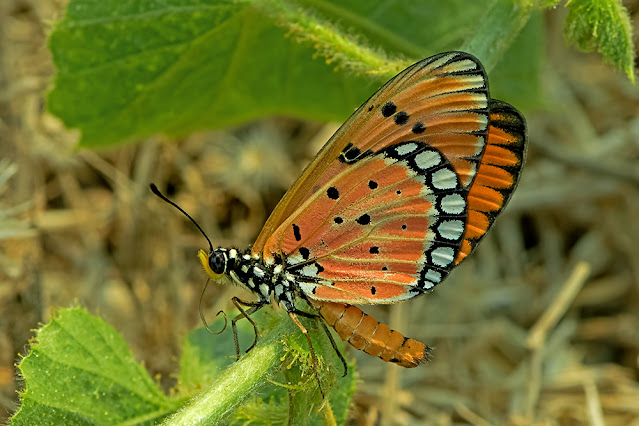
Photo taken at Sri Lanna National Park, Chiang Mai, Thailand. 420m a.s.l.

This species is common and widespread. Like other members of the Acraea genus it has elongated forewings which makes it easy to identify. It prefers open spaces and tends to avoid dense undergrowth and shaded areas. This would normally make it vulnerable to predators. However, it is largely ignored as Acraeini species are believed to be unpalatable to possible predators, especially vertebrates. This unpalatability is due to the presence of toxic cyanoglycosides secreted by the butterfly. It also has a tough exoskeleton and is able to survive a few pecks from a bird. There is little difference in appearance between the sexes but the colours tend to be paler in the female. They have a slow coasting flight and do not fly high, usually under 3m above the ground. Both sexes are avid nectar feeders.
Acraea terpsicore is one of a small group of butterflies that utilize a mating plug or 'sphragis'. When mating the male passes on not only the spermatophore but another waxy substance that hardens and forms a plug in the genital opening of the female. This prevents further attempts at mating by other males. It is multivoltine and there are several broods per annum. The larvae are gregarious and feed in groups, crawling away from the host plant to pupate.
Synonyms: Acraea violae, Papilio violae, Papilio cephea, Telchinia violae, Papilio terpsicore
Taxonomy: Animalia - Arthropoda - Insecta - Lepidoptera - Nymphalidae - Heliconiinae - Acraea - terpsicore
Regional subspecies: there are no subspecies
Regional Distribution: India, Nepal, Bhutan, Bangladesh, Myanmar, Thailand, Laos, Cambodia, Vietnam, Malaysia, Singapore, Indonesia
%20gallery.jpg) |
Sri Lanna National Park, Chiang Mai, Thailand. 420m a.s.l. |
Habitat: Acraea terpsicore is found in open areas including grassland, scrubland, forest edges, wasteland, and can often be seen in urban parks and gardens. It usually stays at moderate elevations but has been recorded up to 2000m a.s.l.
Flight time: all year round, depending on location Wingspan: 50-65mm
Life History: egg 3-4 days instar 1 2-3 days instar 2 2-4 days instar 3 2-4 days instar 4 3-5 days instar 5 4-7 days instar 6 9-13 days pupa 6-7 days Total egg to adult 23-47 days. All times are approximate. NOTE: 6th instar does not always occur.
Larval Hosts: Adenia cordifolia, Adenia heterophylla, Adenia hondala, Passiflora edulis, Passiflora foetida, Passiflora suberosa, Passiflora subpeltata, Turnera subulata, Turnera ulmifolia (Passifloraceae), Pigea enneasperma (Violaceae), Hibiscus cannabinus (Malvaceae), Aporosa cardiosperma (Phyllanthaceae), Tectona grandis, Vitex pinnata (Lamiaceae), Cucumis sativus (Cucurbitaceae), Castilla elastica (Moraceae), Mangifera indica (Anacardiaceae), Musa x paradisiaca (Musaceae), Ipomoea indica (Convolvulaceae), Leucaena leucocephala (Fabaceae). Actual host plant used depends upon location and availabilty of plant species.
Adult Food Sources: Nectar - Duranta erecta, Lantana camara, Stachytarpheta indica, Stachytarpheta jamaicensis, Verbena rigida (Verbenaceae), Ageratina adenophora, Ayapana triplinervis, Bidens alba, Bidens pilosa, Chromolaena odorata, Cosmos sp., Crassocephalum cerpidioides, Cyanthillium cinereum, Cyanthillium conyzoides, Gynura nitida, Lagasca mollis, Lipoblepharis asperrima, Mikania micrantha, Parthenium hysterophorus, Sphagneticola trilobata, Taraxacum javanicum, Tridax procumbens, Xerochrysum bracteatum, Youngia japonica (Asteraceae), Coleus barbatus, Leucas lamiifolia, Premna serratifolia, Rotheca serrata, Vitex negundo (Lamiaceae), Cestrum aurantiacum, Solanum mauritianum (Solanaceae), Hypericum japonicum, Hypericum mysurense (Hypericaceae), Rostellularia procumbens (Acanthaceae), Sida acuta (Malvaceae), Oplismenus undulatifolius (Poaceae), Oxalis latifolia (Oxalidaceae), Cytisus scoparius (Fabaceae), Verbascum thapsus (Scrophulariaceae), Heynea trijuga (Meliaceae), Mappia nimmoniana (Icacinaceae), Rhodomyrtus tomentosa (Myrtaceae), Oenothera rosea (Onagraceae), Prinsepia utilis, Rubus ellipticus (Rosaceae), Rhamnus wightii ( Rhamnaceae), Euphorbia milii, Euphorbia rothiana (Euphorbiaceae), Spermacoce hispida (Rubiaceae), Gomphrena globosa (Amaranthaceae). Other - mud puddling.
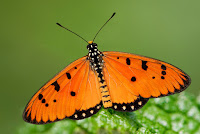 |
| Doi Suthep-Pui National Park, Chiang Mai, Thailand |
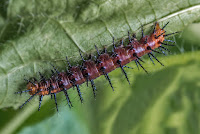 |
| late instar larva |
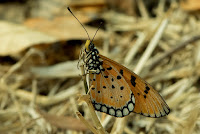 |
| Sri Lanna National Park, Chiang Mai, Thailand |
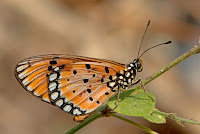 |
| Doi Suthep-Pui National Park, Chiang Mai, Thailand |
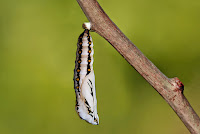 |
| pupa |
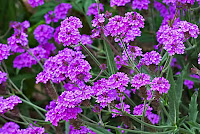 |
| Verbena rigida, a common nectar source |
 |
| Duranta erecta, another nectar source |
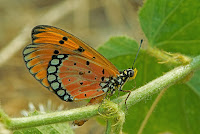 |
| Sri Lanna National Park, Chiang Mai, Thailand |
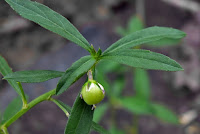 |
| Pigea enneasperma, a larval host |
 |
| Passiflora foetida, another larval host |
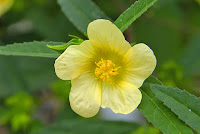 |
| Sida acuta, another nectar source |
Links to other pages in this series for species in the same subfamily
Cethosia cyane
Phalanta phalantha
Vindula erota
